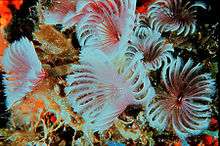Eudistylia
Eudistylia is a genus of marine polychaete worms. The type species is Eudistylia gigantea, now accepted as Eudistylia vancouveri.[1] This worm lives in a parchment-like tube with a single opening from which a crown of tentacles projects when the worm is submerged. It is a sessile filter feeder.
| Eudistylia | |
|---|---|
 | |
| Eudistylia polymorpha | |
| Scientific classification | |
| Kingdom: | |
| Phylum: | |
| Class: | |
| Order: | |
| Suborder: | |
| Family: | |
| Genus: | Eudistylia Bush, 1905 |
| Species | |
|
| |
Characteristics
The head is formed from the prostomium and peristomium, which are fused. It bears two bundles of radioles or feeding tentacles which together form the funnel-shaped branchial crown. Each radiole is pinnately divided and covered in cilia. It has a central stiffening rod of connective tissue, a number of eyespots and a feeding groove. There are a pair of small palps beside the radioles and a large funnel-shaped mouth. There are about eight thoracic segments and the first has a flange-like collar which secures the worm to the mouth of its tube. The thoracic segments bear two rows of setae or bristles, the notochaetae on the dorsal side are grouped in tufts, while the neurochaetae on the ventral side form a row of small hooks. The abdomen is long and has many segments. The position of the setae on the abdominal segments is reversed, with the notochaetae being hooked and the neurochaetae being tufted. The pygidium at the posterior tip bears the large anus. There is a furrow on the dorsal side of the thoracic and abdominal segments called the faecal groove through which faecal material and gametes are transported to the open end of the tube.[2]
Distribution
Members of this genus are found on the Pacific coasts of Canada, the United States and Mexico.[3]
Species
- Eudistylia brevicomata (Ehlers, 1905)
- Eudistylia catharinae Banse, 1979
- Eudistylia ceratodaula (Schmarda, 1861)
- Eudistylia polymorpha (Johnson, 1901)
- Eudistylia tenella Bush, 1904
- Eudistylia vancouveri (Kinberg, 1866) [4]
References
- Bush, Katharine J. 1905. Tubicolous annelids of the tribes Sabellides and Serpulides from the Pacific Ocean. Harriman Alaska Expedition, 12: 169-346.
- Invertebrate Anatomy OnLine Archived 2011-08-01 at the Wayback Machine
- Global Biodiversity Information Facility
- World Register of Marine Species